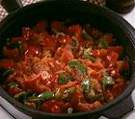| |
|
| The definition of national
food doesn't show any difference between the high-school population
from three separate schools. The students from Poland and Croatia
defined national food as food characteristic of a certain nation,
while the Roumanian children said that a national dish was a dish
that had a long tradition, that was prepared by the majority and was
typical of that particular country. |
| What do these high-school
children know about their national food? 82% of Roumanians knew of
their national food, 15% were not sure, while as much as 91 % of Polish
students knew which food was their national food, and 9% were not
certain. Croatian pupils had the worst results - they knew very little
about our national food, only 34 %. |
| The percentages show us clearly
how ignorant the Croatian high-school students are in comparison to
the Polish and Roumanian pupils. It is hard to explain why it is so,
but they may have been influenced by the huge regionalism present
in Croatia, as well as the fact that there is no particular Croatian
national dish, but a variety of dishes instead. On the other hand
the tradition is not stronger in the rural parts than in the urban
area, so that children in the country become better acquainted with
their nation's customs than the children in the city. The third question
was what would the high-school student's prefer after two hours of
snow clearing - pizza or some national dish. |
| Here again , the Croatian
pupils differ from their coevals in Romania and Poland. Polish (65%)
and Roumanian (77%) children would rather eat something delicious
from their national cuisine, while the pupils in Zagreb prefer pizza.
The life in the city is much faster and more dynamic, and therefore,
preparation of food has to be quicker and simpler than in the rural
parts where the food preparation is not limited by time. |
| The economic chrisis is present
everywhere, including the three countries where the survey has been
conducted, so it isn't surprising to find such a low percentage of
students going to restaurants. Croatians visit restaurants most often
(11 %) while 41 % of examinees go there rarely, as well as 2% of Roumanians
and 22% of Poles. Except from the economic situation, the reason for
such a state is also the fact that the examinees from Croatia live
in a big city, which makes it easier for them to go to restaurants
than the questioned children in Romania and Poland. |
| The fourth question was how
well do we know European cuisine. The most famous European cuisine
is the Italian one. All our examinees (Croatians, Roumanians and Poles)
knew of some Italian dish, but spaghetti was the most famous. The
best cooks in the world haven't done anything to promote their cuisine
in the countries mentioned. The Poles are most familiar with the French
cuisine, with snails being their best-known food. 28% of Roumanians
consider cheese to be a French national dish, while the Croatians
are most familiar with the French salad. German national cuisine is
better known in Croatia (27%) than in Poland and Romania. Most of
Roumanians (80 %), Poles (50%) and Croatians (69%) knew what sushi
was, but a very small number was familiar with alva. It is interesting
to note that Turkey is geographically much closer to us than Japan,
but still few people knew (Roumanians 2%, Croatians 10 %, Poles 0%)
of alva. We believe this is the result of the influence of American
movies, which usually show their stars sitting in Japanese restaurants
eating sushi and not in Turkish ones eating alva. |
| Various cookery books
have defined borsch as a dish typical of different countries. Since
most information we have received said borsch was originally a Russian
national dish, we defined it as such. But we must mention that 80%
of Roumanians consider borsch to be a Ukrainian national dish, 14%
of Poles thinks it is a Russian national dish, as well as 12% of Croatian
students. |
| In
the end something from another continent - tortilla. 18% of Poles
think it comes from Mexico, as well as the same percentage of Roumanians
and 46 % of Croatians. Most of the examinees believe that by preserving
national cuisine we preserve national identity. Also, most of them
would offer their national food to a foreigner. Our Roumanian partner
has found out which dish that would be: Giblets soup, forcemeat rolls
of cabbage, grilled meat with salad, cotonari wine and apple pie.
It is the same food that 62% of examinees cook for holidays. |
| The
question still remains have we proved our hypothesis that the young
are not so familiar with their country's national cuisine. When talking
about Poland and Romania our hypothesis is not worth a dime, since
they know very well what is their national food. In Croatia the situation
is completely different - high-school children here are not familiar
with our national food and eat fast food instead. |
| Whether
they know their country's national food or not has no influence on
their knowledge of other cultures' cuisines. This is influenced by
the mass media, which, when used correctly, can educate the young
about the differences among nations, as well as the unity of all people.
The problem with our high-school population is obviously their lifestyles
that dictate how fast they should live and the instant food that goes
along. |
| In the end,
we have a suggestion for you. In the next pages there are recipes
from our national cuisines. What we want you to do is choose one of
them, invite your friends and try to make "ricet" (barley broth) together.
Relax, have fun and enjoy your meal. |
| |
| |
| |
| |
|

